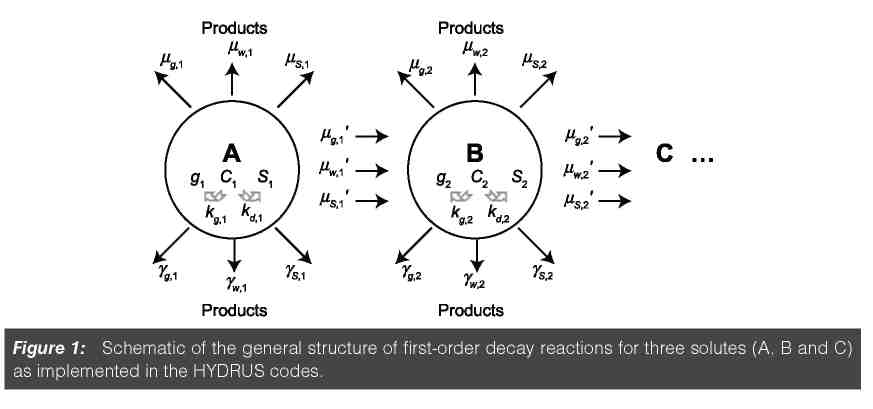
- •1 Вступ
- •2 Пакети програмного забезпечення hydrus
- •3 Переміщення розчинів
- •3.1 Переміщення поодиноких іонів
- •3.2 Transport of multiple ions subject to sequential frst-order decay reactions
- •3.3 Transport of mutually dependent multiple ions
- •4 Specialized hydrus Modules
- •4.1 The hp1/hp2 modules
- •4.3 The DualPerm module
- •4.4 The UnsatChem module
- •4.5 The Wetland module
- •4.6 The Fumigants module
- •5 Conclusions
3.2 Transport of multiple ions subject to sequential frst-order decay reactions
Versions 1 of the windows-based HYDRUS codes (Tables 1 and 2) included an option to simulate the transport of multiple solutes subject to sequential frst-order decay reactions. Figure 1 shows schematically how these decay reactions are implemented. In the fgure, c, s, and g represent concentrations in the liquid, solid, and gaseous phases, respectively, the subscripts s, w, and g refer to solid, liquid and gaseous phases, respectively, straight arrows represent the different zero-order (γ ) and frst-order (µ, µ') rate reactions, while circular arrows indicate equilibrium distribution coeffcients between the liquid and gaseous phases (kg) and liquid and solid phases (kd).
The decay chain option in HYDRUS, in which solute A degrades to produce solute B, solute B produces solute C, and so on, has proved to be very attractive for modeling the fate and transport of different types of solutes. Typical examples of sequential frst-order decay chains involve radionuclides, mineral nitrogen species, certain pesticides, chlorinated aliphatic hydrocarbons, hormones, antibiotics, and explosives. Mallants et al.49 used this structure to simulate the transport of the radionuclides 226Ra, 222Rn, and 210Pb, with Ra and Pb sorbing to the solid phase and Rn being volatile and diffusing also in the gas phase. Another example with radionuclides is given by Pontedeiro et al.50 who evaluated the subsurface transport of 238U, 234U, 230Th, 226Ra, and 210Pb after being released from a conventional mining installation processing ore containing naturally occurring radioactive materials.
HYDRUS was used similarly in several stud-ies51–53 to simulate the transport of nitrogen species involved in a nitrifcation/denitrifcation chain. The reaction pathway in this case involves the hydrolysis of urea ((NH2)2CO) by heterotrophic bacteria to form ammonium (NH4+), which is sequentially nitrifed by autotrophic bacteria to nitrite (NO2-) and nitrate (NO3-), with nitrate in

turn being denitrifed to form di-nitrogen (N2 and N2O). In this reaction pathway, ammonium is a sorbing and volatile species that can be present in the liquid phase as well as in the solid and gaseous phases.
Additional HYDRUS-1D examples for sequential decay chains are given by Wehrhan et al.54 and Unold et al.55 who investigated the fate and transport of the antibiotic sulfadiazine (SDZ) and its main transformation products in pig manure. Casey and Šimu˚nek56 and Schaerlaekens et al.57 considered frst-order degradation for the transport of trichloroethylene (TCE). Microbiological degradation of perchloroethylene (PCE) under anaerobic conditions follows a series of chain reactions in which, sequentially, trichloroethylene (TCE), cis-dichloroethylene (c-DCE), vinylchlo-ride (VC), and ethene are generated.
The transport of hormones was investigated using HYDRUS-1D by Casey et al.,58–60 Das et al.,61 and Fan et al.62 Casey et al.58,60 and Das et al.61 studied the transport of estrogenic hormones, i.e., 17β-estradiol and its primary metabolite estrone, in natural soil. Casey et al. (2004)59 and Das et al.61 evaluated the transport of androgenic hormones (i.e., testosterone and its primary metabolite androstenedione). Papiernik et al.63 further used HYDRUS-1D to evaluate the transport of the herbicide isoxafutole and its diketonitrile and ben-zoic acid metabolites. Bradford et al.64 similarly used a variant of the sequential frst-order decay model to simulate the transport and retention behavior of monodispersed and aggregated species of pathogenic E. coli O157:H7. We further note the work by Dontsova et al.65,66 who analyzed the fate and transport of explosives. Additional examples in which HYDRUS was used to simulate the transport of frst-order degradation chains can be found in the literature.
